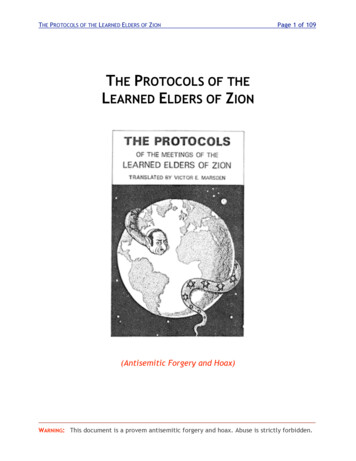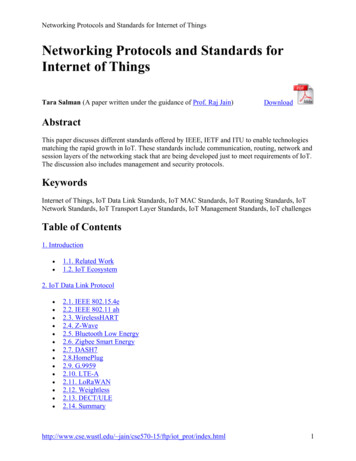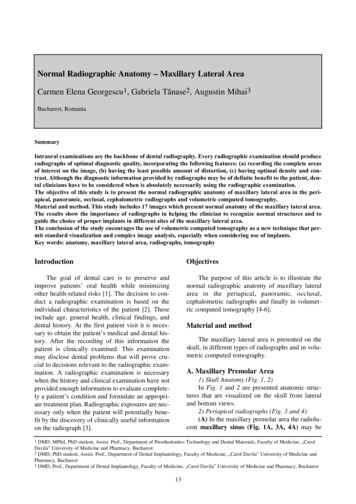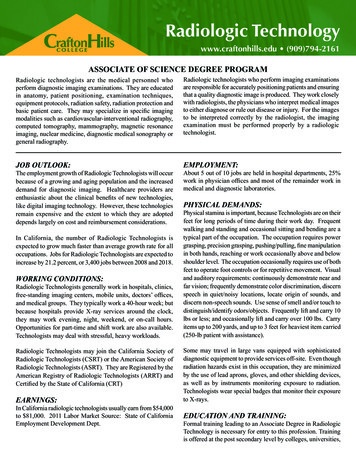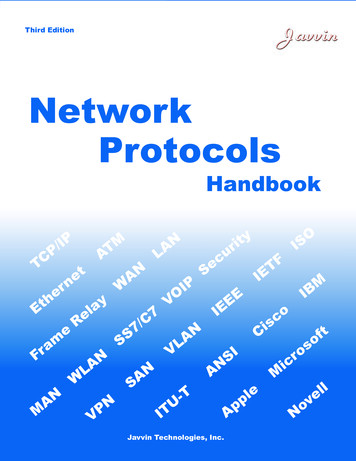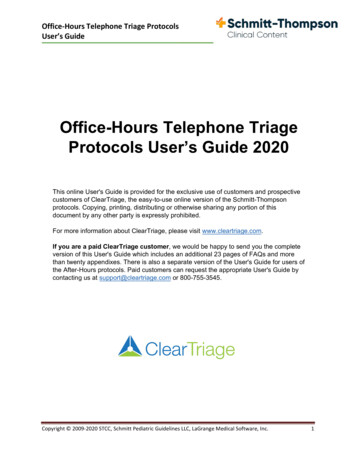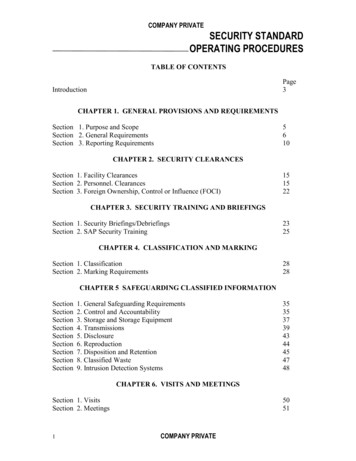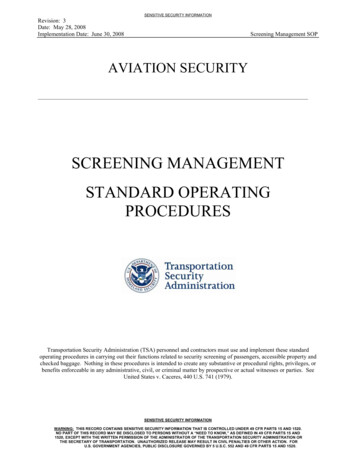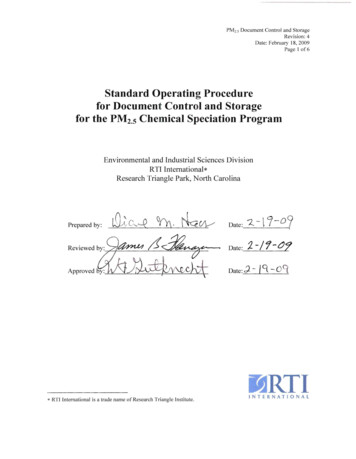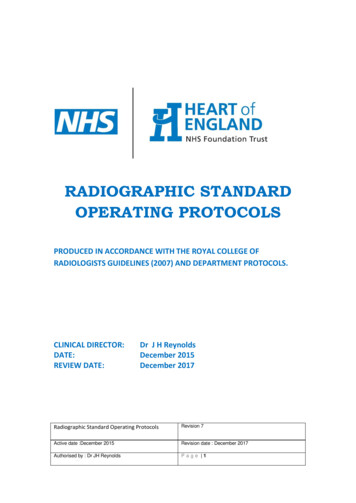
Transcription
RADIOGRAPHIC STANDARDOPERATING PROTOCOLSPRODUCED IN ACCORDANCE WITH THE ROYAL COLLEGE OFRADIOLOGISTS GUIDELINES (2007) AND DEPARTMENT PROTOCOLS.CLINICAL DIRECTOR:DATE:REVIEW DATE:Dr J H ReynoldsDecember 2015December 2017Radiographic Standard Operating ProtocolsRevision 7Active date :December 2015Revision date : December 2017Authorised by : Dr JH ReynoldsP a g e 1
META DATATITLERadiographic Standard Operating ProtocolsDATEDECEMBER 2015Review dateDECEMBER 2017Created byRadiology (Clinical Director – Radiology)Stored CentrallyTrust IntranetRevisions (details)11/12/2014 Alteration to Mandible referral criteria06/02/2015 Alteration to chest & Abdomen referral criteriafollowing button battery ingestion safety alertDecember 2015 include Community dentalLinked TrustStrategies andPoliciesClinical GovernanceIR(ME)R 2000 Procedures and protocolsRadiographic Standard Operating ProtocolsRevision 7Active date :December 2015Revision date : December 2017Authorised by : Dr JH ReynoldsP a g e 2
TABLE OF CONTENTSINTRODUCTION . 9STANDARD RADIOGRAPHIC PROJECTIONS.11SKELETAL SURVEY VIEWS.19SKELETAL DYSPLASIA SURVEY .20RENAL SKELETAL SURVEY .21MYELOMA SKELETAL SURVEY .21BONE AGE .22PROTOCOL FOR RADIOLOGY IN SUSPECTED NON ACCIDENTAL INJURY IN CHILDREN.23RADIOGRAPHIC STANDARD OPERATING PROTOCOLS (GENERAL EXAMINATIONS) 27EXAMINATION PROTOCOL NO 1 AREA: SKULL .29EXAMINATION PROTOCOL NO 2 AREA: FACIAL BONES / ORBITS .30EXAMINATION PROTOCOL NO 2 AREA: FACIAL BONES / ORBITS .30EXAMINATION PROTOCOL NO 3 AREA MANDIBLE .31TEMPORO MANDIBULAR JOINTS .31EXAMINATION PROTOCOL NO 4 AREA: SINUSES.32EXAMINATION PROTOCOL NO 5 AREA: MASTOIDS .33EXAMINATION PROTOCOL NO 6 AREA: CERVICAL SPINE .34EXAMINATION PROTOCOL NO 7 AREA: THORACIC SPINE / LUMBAR SPINE .35EXAMINATION PROTOCOL NO 8 AREA: PELVIS/ HIP .38EXAMINATION PROTOCOL NO 9 AREA: SACRUM .41EXAMINATION PROTOCOL NO 10 AREA: CHEST .42EXAMINATION PROTOCOL NO: 11 AREA: THORACIC INLET .46EXAMINATION PROTOCOL NO 12 AREA: ABDOMEN .47EXAMINATION PROTOCOL NO 13 AREA: KNEE.49EXAMINATION PROTOCOL NO 14 AREA: ANKLE.52Radiographic Standard Operating ProtocolsRevision 7Active date :December 2015Revision date : December 2017Authorised by : Dr JH ReynoldsP a g e 3
EXAMINATION PROTOCOL NO 15 AREA: FOOT .53EXAMINATION PROTOCOL NO 16 AREA: FEMUR/ TIBIA/ FIBULA .56EXAMINATION PROTOCOL NO 17 AREA: HAND .57EXAMINATION PROTOCOL NO 18 AREA: WRIST.58EXAMINATION PROTOCOL NO 19 AREA: ELBOW.60EXAMINATION PROTOCOL NO 20 AREA: SHOULDER .61EXAMINATION PROTOCOL NO 21 AREA: HUMERUS/RADIUS/ULNA .63EXAMINATION PROTOCOL NO 22 AREA: MAJOR TRAUMA - (ATLS) .64EXAMINATION PROTOCOL NO 23 AREA: COLONIC TRANSIT STUDIES.65RADIOGRAPHIC STANDARD OPERATING PROTOCOLS (MOBILE AND THEATREEXAMINATIONS) .67MOBILE SCREENING PROCEDURES .67EXAMINATION PROTOCOL NO: 1 AREA: TEMPORARY PACEMAKER .69EXAMINATION PROTOCOL NO: 2 AREA: ERCP .70EXAMINATION PROTOCOL NO: 3 AREA: PIC/ HICKMAN LINE.71EXAMINATION PROTOCOL NO: 4 AREA: ON TABLE ANGIOGRAPHY .72EXAMINATION PROTOCOL NO 5 AREA: P.C.N.L.73EXAMINATION PROTOCOL NO: 6 AREA: RETROGRADE PYELOGRAMS .74EXAMINATION PROTOCOL NO: 7 AREA: CYSTOSCOPY .75EXAMINATION PROTOCOL NO: 8 AREA: URETERIC STENT .76EXAMINATION PROTOCOL NO: 9 AREA: URETEROSCOPY .77EXAMINATION PROTOCOL NO: 10 AREA: VASOGRAMS .78EXAMINATION PROTOCOL NO: 11 AREA: OPEN REDUCTION INTERNAL FIXATION .79EXAMINATION PROTOCOL NO: 12 AREA: MANIPULATION UNDER ANAESTHETIC .80EXAMINATION PROTOCOL NO: 13 AREA: LOCATION OF LOST INTRA-OPERATIVEEQUIPMENT .81EXAMINATION PROTOCOL NO: 14 AREA: REMOVAL OF FOREIGN BODIES .82EXAMINATION PROTOCOL NO: 15 AREA: ARTHROGRAMS .83EXAMINATION PROTOCOL NO: 16 AREA: REMOVAL OF METAL WORK .84MOBILE PLAIN FILMS .85EXAMINATION PROTOCOL NO: 17 AREA: MOBILE CHEST .85EXAMINATION PROTOCOL NO: 18 AREA: MOBILE SKELETAL RADIOGRAPHY .86EXAMINATION PROTOCOL NO: 19 AREA: MOBILE ABDOMINAL RADIOGRAPHY .87Radiographic Standard Operating ProtocolsRevision 7Active date :December 2015Revision date : December 2017Authorised by : Dr JH ReynoldsP a g e 4
RADIOGRAPHIC STANDARD OPERATING PROTOCOLS FLUOROSCOPYEXAMINATIONS .88EXAMINATION PROTOCOL NO: 1 AREA: CONTRAST SWALLOWS / MEALS.89EXAMINATION PROTOCOL NO: 2 AREA: CONTRAST FOLLOW THROUGH .91EXAMINATION PROTOCOL NO: 3 AREA: CONTRAST ENEMA.92EXAMINATION PROTOCOL NO: 4 .95AREA: SMALL BOWEL ENEMA .95EXAMINATION PROTOCOL NO: 5 AREA: GASTRIC BANDS .96EXAMINATION PROTOCOL NO: 6 AREA: HYSTEROSALPINGOGRAMS .97EXAMINATION PROTOCOL NO: 7 AREA: UROLOGY CASES – .98EXAMINATION PROTOCOL NO: 8 AREA: MYELOGRAMS . 100EXAMINATION PROTOCOL NO: 9 AREA: SINOGRAMS / FISTULOGRAMS . 101EXAMINATION PROTOCOL NO: 10 AREA: SIALOGRAMS –SUBMANDIBULAR/PAROTID . 102EXAMINATION PROTOCOL NO: 11 AREA: ARTHROGRAM. 103EXAMINATION PROTOCOL NO: 12 AREA: HERNIOGRAMS . 104EXAMINATION PROTOCOL NO: 13 AREA: VIDEOFLUOROSCOPY . 105EXAMINATION PROTOCOL NO: 14 AREA: LUMBAR PUNCTURE UNDER SCREENINGCONTROL . 106EXAMINATION PROTOCOL NO: 15 AREA: VIDEOPROCTOGRAPHY . 107EXAMINATION PROTOCOL NO: 16 AREA: INJECTION OF TUBES . 108EXAMINATION PROTOCOL NO: 17 AREA: IVU . 109EXAMINATION PROTOCOL NO: 18 AREA: EMERGENCY IVU . 110EXAMINATION PROTOCOL NO: 19 AREA: T TUBE CHOLANGIOGRAM . 111INTERVENTIONAL/VASCULAR EXAMINATIONS . 112EXAMINATION PROTOCOL NO: 1 AREA: PERIPHERAL ANGIOGRAPHY . 113EXAMINATION PROTOCOL NO: 2 AREA: MESENTERIC ANGIOGRAPHY. 114EXAMINATION PROTOCOL NO: 3 RE: ARCH AORTOGRAM. 115EXAMINATION PROTOCOL NO: 4 AREA: SELECTIVE CAROTID ANGIOGRAPHY . 116EXAMINATION PROTOCOL NO: 5 AREA: RENAL ANGIOGRAPHY . 117EXAMINATION PROTOCOL NO: 6 AREA: PERCUTANEOUS TRANSHEPATICCHOLANGIOGRAM (PTC) . 118EXAMINATION PROTOCOL NO: 7 AREA: PERCUTANEOUS NEPHROSTOMY. 119EXAMINATION PROTOCOL NO: 8 AREA: UTERINE ARTERY EMBOLISATION . 120Radiographic Standard Operating ProtocolsRevision 7Active date :December 2015Revision date : December 2017Authorised by : Dr JH ReynoldsP a g e 5
EXAMINATION PROTOCOL NO: 9 AREA: VARICOCELE EMBOLISATION . 121EXAMINATION PROTOCOL NO: 10 AREA: I.V.C.FILTER INSERTION . 122EXAMINATION PROTOCOL NO: 11 AREA: FACET JOINT, EPIDURAL AND NERVE ROOTBLOCK SPINAL INJECTIONS . 123EXAMINATION PROTOCOL NO: 12 AREA: DACROCYSTOGRAM. 124EXAMINATION PROTOCOL NO: 13 AREA: TUNNELLED CENTRAL LINE / PICC LINE . 125EXAMINATION PROTOCOL NO: 14 AREA: DIALYSIS CATHETER . 126EXAMINATION PROTOCOL NO: 15 AREA: FISTULOGRAM AND FITULOPASTRY . 127EXAMINATION PROTOCOL NO: 16 AREA: SVC STENT . 128C.T. EXAMINATIONS. 129EXAMINATION PROTOCOL NO 1 AREA: CT BRAIN . 130EXAMINATION PROTOCOL NO 2 AREA: CT SINUSES . 134EXAMINATION PROTOCOL NO 3 AREA: CT MASTOIDS/ PETROUS BONES. 135EXAMINATION PROTOCOL NO 4 AREA: CT ORBITS . 136EXAMINATION PROTOCOL NO 5 AREA: CT NECK . 137EXAMINATION PROTOCOL NO 6 AREA: CT THORAX . 138EXAMINATION PROTOCOL NO 7 AREA: CT ABDOMEN . 142EXAMINATION PROTOCOL NO 8 AREA: CT EXTREMITIES . 149EXAMINATION PROTOCOL NO 9 AREA: CT /MR ARTHROGRAPHY . 150EXAMINATION PROTOCOL NO 10 AREA: CT LEG LENGTH/PELVIMETRY . 151EXAMINATION PROTOCOL NO 11 AREA CT CERVICAL, THORACIC AND LUMBARSPINE . 152EXAMINATION PROTOCOL NO 12 AREA: CT ANGIOGRAPHY/VENOGRAPHY . 153EXAMINATION PROTOCOL NO 13 AREA: CT CARDIAC . 156MAMMOGRAPHY EXAMINATIONS . 158EXAMINATION PROTOCOL NO: 1 AREA:EXAMINATION PROTOCOL NO: 2 AREA:EXAMINATION PROTOCOL NO: 3 AREA:EXAMINATION PROTOCOL NO: 4 AREA:BREAST . 159BREAST: STEREOTATIC LOCALISATION . 160BREAST: STEREOTATIC CLIP MARKING . 161BREAST: STEREOTATIC CLIP MARKING . 162DENTAL EXAMINATIONS . 163EXAMINATION PROTOCOL NO: 1 AREA: OPG . 164Radiographic Standard Operating ProtocolsRevision 7Active date :December 2015Revision date : December 2017Authorised by : Dr JH ReynoldsP a g e 6
EXAMINATION PROTOCOL NO 2 AREA: LATERAL CEPHALOSTAT . 166EXAMINATION PROTOCOL NO: 3 AREA: OCCLUSAL FILM . 167BONE DENSITOMETRY EXAMINATIONS . 168EXAMINATION PROTOCOL NO: 1 AREA: LUMBAR SPINE, BOTH HIPS . 169RADIOGRAPHIC STANDARD OPERATING PROTOCOLS . 171CARDIOLOGY EXAMINATIONS . 171EXAMINATION PROTOCOL NO 1 AREA: DIAGNOSTIC CORONARY ANGIOGRAPHY. 172EXAMINATION PROTOCOL NO 2 AREA: RIGHT HEART CATHETER /- RV BIOPSY . 174EXAMINATION PROTOCOL NO 3 AREA: CORONARY ANGIOPLASTY. 175EXAMINATION PROTOCOL NO 4 AREA: VALVULOPLASTY . 176EXAMINATION PROTOCOL NO 5 AREA: PERICARDIOCENTESIS. 177EXAMINATION PROTOCOL NO 6 AREA: TEMPORARY AND PERMANENT PACEMAKERINSERTION . 178EXAMINATION PROTOCOL NO 7 AREA: INTERNAL CARDIOVERSION . 179EXAMINATION PROTOCOL NO 8 AREA: INTRA VASCULAR ULTRASOUND (IVUS) OROPTICAL COHERENCE TOMOGRAPHY (OCT) . 180EXAMINATION PROTOCOL NO 9 AREA: INTRA AORTIC BALLOON PUMP (IABP)INSERTION . 181EXAMINATION PROTOCOL NO 10 AREA: IMPLANTABLE CARDIOVERTERDEFIBRILATOR (ICD) INSERTION . 182EXAMINATION PROTOCOL NO 11 AREA: BIVENTRICULAR PERMENENT PACEMAKERINSERTION . 183NUCLEAR MEDICINE STANDARD OPERATING PROTOCOLS . 184RADIONUCLIDE STATIC RENAL IMAGING . 185RADIONUCLIDE DYNAMIC RENAL IMAGING . 185RADIONUCLIDE LUNG IMAGING . 188RADIONUCLIDE BONE IMAGING . 190RADIONUCLIDE INFECTION IMAGING . 192HMPAO LABELLED WHITE CELL SCAN. 194RADIONUCLIDE THYROID IMAGING . 196Radiographic Standard Operating ProtocolsRevision 7Active date :December 2015Revision date : December 2017Authorised by : Dr JH ReynoldsP a g e 7
RADIONUCLIDE PARATHYROID IMAGING . 197RADIONUCLIDE DACROSCINTIGRAM. . 198RADIONUCLIDE MECKELS STUDY. . 199RADIONUCLIDE GI BLEEDING STUDY. 200RADIONUCLIDE LYMPHOSCINTIGRAM. . 201RADIONUCLIDE SENTINEL LYMPH NODE BIOPSY . 203RADIONUCLIDE TUMOUR IMAGING . 204RADIONUCLIDE CARDIAC IMAGING . 209RADIONUCLIDE HEPATO-BILIARY IMAGING . 211RADIONUCLIDE GASTRIC EMPTYING. 213RADIONUCLIDE DATSCAN (BRAIN) . 214TREATMENT PROTOCOL FOR ORAYA THERAPY . 214Radiographic Standard Operating ProtocolsRevision 7Active date :December 2015Revision date : December 2017Authorised by : Dr JH ReynoldsP a g e 8
INTRODUCTIONThis document has been written in line with Ionising Radiation (Medical Exposure)Regulations 2000(IR (ME) R) 2000 legislation to ensure that local Radiology referralprotocols are communicated to all referrers utilising the services of Radiology.The new regulations came into force in January 2001 and replace the Protection ofPersons undergoing medical Exposure or Treatment 1988 (POPUMET 1988). Thisnew legislation identifies changes, which have a significant impact on the requesting,reporting and management of the referral to Radiology.Some of the specific impact is discussed below (a full copy of the legislation isavailable from Radiology if required)In line with IR (ME) R 2000, a correctly completed Department of Radiology referralmust be submitted prior to investigation for every Radiological examination. Thisshould be completed electronically when electronic access is available. Paperrequests will only be accepted where electronic access is not available.The patient must be identifiable from the request card. Name, Date of birth, addresshospital number and/or NHS number, if available must all be present.Clinical details must conform to those in the Radiology department protocolsenclosed. If they do not, or there is insufficient information to justify the x-ray, thenthe examination cannot be performed.The referrer must be identifiable. If the request is not submitted electronically theremust be the referrer’s signature and name written legibly in block capitalsFor females of reproductive age where the investigation involves irradiating theabdomen and all nuclear medicine examinations, the date of the last menstrualperiod must be written. If the examination is to be carried out whilst the patient ispregnant then the form should be signed accordingly.If the request card is incompletely or illegibly completed, legally the examinationcannot be performed under this legislation.Under IRMER legislation the referrer must supply sufficient medical information toenable the practitioner to justify the exposure. It is intended that the followingprotocols will assist the referrer to ensure that the patient receives an exposure toRadiographic Standard Operating ProtocolsRevision 7Active date :December 2015Revision date : December 2017Authorised by : Dr JH ReynoldsP a g e 9
radiation only when the result will affect the management of that patient, thuskeeping the overall dose to the population as low as reasonably achievable.If you have any questions relating to the protocols or need further clarification onany issue relating to the IRMER regulations please contact a Consultant Radiologistor Advanced Practitioner Radiographer who will be happy to offer assistance andsupport as appropriate.Radiographic Standard Operating ProtocolsRevision 7Active date :December 2015Revision date : December 2017Authorised by : Dr JH ReynoldsP a g e 10
DEPARTMENT OF RADIOLOGYSTANDARD RADIOGRAPHIC upine ? Perforation, erect chest alsorequired.Diaphragm to symph must beincluded, especially for customscases.Additional lateral rectum may berequired for customs cases or for?FB rectumChestPA RibsPA ChestThoracic InletPenetrated PA LATsoft tissue neckLAT Thoracic InletLateral view if indicated from PAfilm, or if requested by thoracicteam.Oblique if indicated AP and lateral thoracic inlet mustinclude the bifurcation of thetrachea.UPPER LIMBShoulder followingtraumaAPLateral scapula for post traumapatients who cannot obtain theaxial. Axial or inferior superior arethe preferred second projectoinAxialPost Dislocation films. AP only.Radiographic Standard Operating ProtocolsRevision 7Active date :December 2015Revision date : December 2017Authorised by : Dr JH ReynoldsP a g e 11
AP ViewConed AP 45 degree oblique todemonstrate gleno-humeral jointShoulder for GPpatientsAxial view performed only if ?stability or inadequatedemonstration of gleno-humeralon coned AP view.NB: Supraspinatus viewsperformed as requested, 10-15degree caudal angle centred at thrposterior superior aspect of thehumeral head.ClavicleAPAP 20 to show the degree ofdisplacement of the fracture site.AP20SternumLateralAcromio-ClavicularJointsAP (coned to joint)Weight bearing and non weightbearing of both sidesSterno ClavicularJointsPACone to include both joints on eachfilm.HumerusAPOBLIQUESTo include both joints on filmLateralElbowAPTo visualise radial head Externallyrotate arm on AP view.Radiographic Standard Operating ProtocolsRevision 7Active date :December 2015Revision date : December 2017Authorised by : Dr JH ReynoldsP a g e 12
LateralForearmAPTo include both jointsLateralWristAPTrue lateral is very importantLateralWrist InstabilitySeriesClenched fist DP &lateral – bothwristsUlna VarianceViewsShoulder & ElbowMUST be at 90degreesX-ray wrist withclenched fist – DP& horizontal beamlateral, both sidesScaphoid (on initialvisit)Injured side only DP radius andthen with ulna deviation ( 6 viewsin total)4 views in total)PAWith ulnar deviation.PA 30LateralObliqueHandFingersPAFor? FB do a lateralObliqueIf fracture 5th MC do true lateralPAAlways include one finger eitherRadiographic Standard Operating ProtocolsRevision 7Active date :December 2015Revision date : December 2017Authorised by : Dr JH ReynoldsP a g e 13
Lateralside of injury.APPlace film diagonallyLateralBoth joints to be viewedAPTrauma knees should be donehorizontal beam on 24x30LOWER LIMBFemurKneeLateralStanding knees as requested fromorth. Clinic.Skyline views should be routinelyundertaken for all GP and OPreferralsOblique views at the request ofT&O for ? tibial plateau fracture.Tibia & FibulaAPBoth joints must be visualised.LateralAnkleAPThe whole of the joint needs to bevisualised on the AP viewLateralFootAPLateral for FBObliquePELVISPelvis/hipsAP 1.Frog lateral for Perthe’s disease.(Lead protection should be used onall follow up)2.Lateral hip at request of T/ORadiographic Standard Operating ProtocolsRevision 7Active date :December 2015Revision date : December 2017Authorised by : Dr JH ReynoldsP a g e 14
usually for sub capital fractureassessment.For initial visit always do both hipswith AP of the affected hip forfollow up visitsInclude the distal stem of any hipprostheses.Sacro-iliac JointsPA 15-20 Obliques caudallyProne or supine oblique ifrequested separately withoutpelvis or if SIJ clearly seen on APpelvis.LateralOpen mouth only for trauma.SPINECervical SpineAP Must visualise C7-T1 on lateralOpen Mouth Flexion and extension/ swimmersas requested.(trauma only)3. Oblique views of the c.spine maybe requested in trauma cases ifappropriate.Thoracic SpineLumbar SpineAP Lateral AP Lateral Long exposure time for lateral.1.If done in conjunction with apelvis AP can be done on a 24x302. Must include the SIJ.SacrumL5 S1 if not shownon the lateral AP15 Coned L5-S1 must be done if notshown on the lateral filmRadiographic Standard Operating ProtocolsRevision 7Active date :December 2015Revision date : December 2017Authorised by : Dr JH ReynoldsP a g e 15
Lateral Radiographic Standard Operating ProtocolsRevision 7Active date :December 2015Revision date : December 2017Authorised by : Dr JH ReynoldsP a g e 16
SKULLSkullPA 20TownesHorizontal beam for trauma LateralFacial BonesOMOM 30OrbitsMandibleSlit townes for zygoma OMOM30 PALateral Obliques PAFor FB PA 30 caudal (slit beam)eyes looking up.If FB presentdo look down.For traumaFor swellingOpen & ClosedTMJ on OPGmachineFor TMJ subluxationOPG for ? dental abscessLoose dentition post traumaMastoidsSlit TownesObliquesTMJLateral Obliques25 caudal tiltSinusesOM Both sides open and closed. Horizontal beam for all viewsLateralParotid GlandPAObliques LateralRadiographic Standard Operating ProtocolsRevision 7Active date :December 2015Revision date : December 2017Authorised by : Dr JH ReynoldsP a g e 17
Sub-MandibularGlandPALateral-TongueDepressed Intra-oralSwallowedForeign BodyLAT Soft TissueNeckIf swallowed 30 minutes agoCXRChests only are done if: ? inhaled FB- viewshould be taken onexpirationImmediate Chest & Abdomenif: Potential / suspectedingestion of buttonbattery (child 6 years &under); may be unwitnessed ingestionChest & Abdomen for knowningestion of button battery if symptoms developpost 4 days ingestion if 15mm cell by child 6yearspost 10-14 daysingestion to confirmpassageExcept for sharp or potentiallypoisonous objects i.e.batteries.AXR not routinelyindicatedRadiographic Standard Operating ProtocolsRevision 7Active date :December 2015Revision date : December 2017Authorised by : Dr JH ReynoldsP a g e 18
SKELETAL SURVEY VIEWSPATHOLOGYVIEWSCOMMENTSO.A./R.A.Initial VisitRoutine views ofareas requestedFollow-upHandsHands & wristsPA only on followup assessmentsIf request asks for hands and wrists aim toinclude as much of the wrist as possible.Separate wrist views are not necessary.KneesAPAnklesAPFeetAPShouldersAPTo show joint space clearly (please clarifyare we looking for gleno-humeral joint?)in all cases.HipsAPPelvis to include iliac crests and greatertrochanters.Radiographic Standard Operating ProtocolsRevision 7Active date :December 2015Revision date : December 2017Authorised by : Dr JH ReynoldsP a g e 19
SKELETAL DYSPLASIA SURVEYChestPA/APAs appropriatePelvisAPAs appropriateSkullLateralAs appropriateLeft humerusAPAs appropriateLeft ForearmAPAs appropriateLeft handDPAs appropriateLeft femurAPAs appropriateLeft tibia/fibulaAPAs appropriateThoraco-Lumbar SpineAP/LateralAs appropriateRadiographic Standard Operating ProtocolsRevision 7Active date :December 2015Revision date : December 2017Authorised by : Dr JH ReynoldsP a g e 20
RENAL SKELETAL SURVEYAREAVIEWChestPAPelvisAPSkullLateralThoracic SpineLateralLumbar SpineLateralHands (both)PAMYELOMA SKELETAL SURVEYChestPAPelvisAPSkullLateralThoracic SpineLateralLumbar SpineLateralHumeriAPFemoraAPMRI FULL SPINEWhen appropriate insteadof plain filmsNB Allocate images to Dr B Miller and Dr S Cooper at BHH/SH and Dr M Cleasby atGHH.Radiographic Standard Operating ProtocolsRevision 7Active date :December 2015Revision date : December 2017Authorised by : Dr JH ReynoldsP a g e 21
BONE AGENon dominant Hand andwristPACan be performed via G.P.referralN.b. X-rays should be performed in line with departmental protocol an example ofwhich can be found in each viewing area . The following criteria should be followed:The non dominant hand and wrist should be included with the axis of the middlefinger in direct axis with forearm.The upper arm and forearm should be in the same horizontal plainTube should be centred above the head of the 3rd metacarpalThe FFD should be 76cmsThe fingers should be positioned so that they are just not touching with the thumb ina comfortable position at about 30 degrees to the first finger.Radiographic Standard Operating ProtocolsRevision 7Active date :December 2015Revision date : December 2017Authorised by : Dr JH ReynoldsP a g e 22
PROTOCOL FOR RADIOLOGY IN SUSPECTEDNON ACCIDENTAL INJURY IN CHILDRENProtocol for the Provision of Forensic Radiography in Suspected Non AccidentalInjury in PaediatricsTraining RequirementsTraining on local NAI procedures- Documented on induction sign off.Safeguarding Children Level 1 (covered within mandatory training daybi-annually)Safeguarding Children Level 2 (mandatory training tri-annually).Pre Examination‘Procedures to be followed for ALL Forensic Investigations’ should be read prior toundertaking this examination.Examination requested XR Skeletal survey non-accidental injury (XSSNA).The referral should originate following discussion with a Paediatric Consultant andbe discussed with an appropriate supervising practitioner (Consultant Radiologist).The request is to be authorised by an appropriate supervising practitioner, indicatingthis in the Practitioner and Intended Radiologist fields on CRIS. The examination is tobe carried out within 24 hours wherever possible.Exceptional circumstances, for example an unstable clinical condition, may delay theperformance of the skeletal survey. Where a child remains as an in-patient andwhen there are no child protection concerns about siblings within the home, it maybe deferred for up to 72 hours.The ward should be verbally informed of an appointment date and time, betweenthe hours of 9am – 5pm, and those parents / carers need to be presented withinformation about the risk/benefit of radiation in order to ensure that properconsent is achieved. If the clinician is in doubt of this – contact Radiology. A‘Parental agreement to investigation or treatment for a child or young person’consent form will be completed prior to the child attending the department. It isRadiographic Standard Operating ProtocolsRevision 7Active date :December 2015Revision date : December 2017Authorised by : Dr JH ReynoldsP a g e 23
NOT the radiographer’s responsibility to give this information OR to gain consent.Document appointment date and time of the examination and the named nurse ofwhom this was communicated to in the ‘Event Comments’ field on CRIS.ExaminationAn appropriate room will be nominated within departments, preferably where DirectDigital Radiography Equipment can be used. Ensure the date and time is correctbefore carrying out any imaging.The examination must be performed by 2 qualified radiographers – one of whichshould be Band 6 or above. The witness, i.e. a paediatric nurse or othe
Radiographic Standard Operating Protocols Revision 7 Active date :December 2015 Revision date : December
